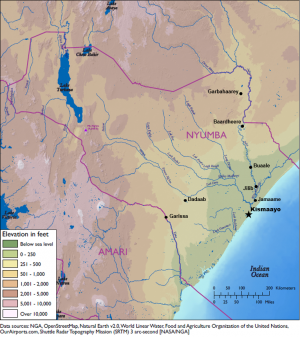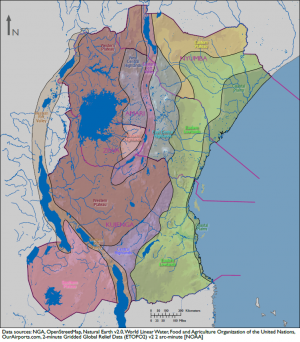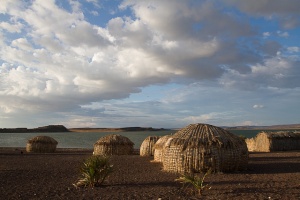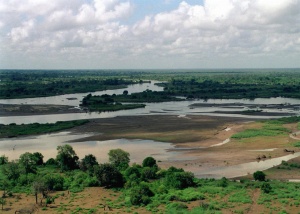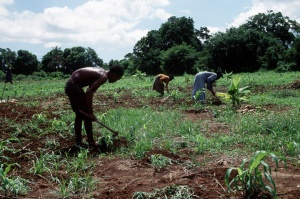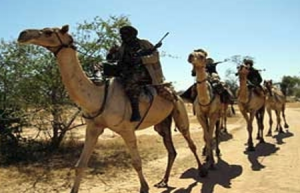Physical Environment: Nyumba
Nyumba is a moderately large country located in eastern Africa. It borders one major body of water: the Indian Ocean and encompasses two others, Lake Turkana and Lake Logipi. The country’s terrain varies from significant a rift valley, high mountains and arid desert lowlands, as well as coastal plains, with climates ranging from east, tropical to semiarid and in the west, warm desert and arid and humid near the coast.
Contents
Table of Physical Environment Data
| Measure | Data | Remarks |
|---|---|---|
| Total Area (sq. miles) | 165,340 | Includes inland water |
| Land Area (sq. miles) | 161,998 | Excludes inland water |
| Inland Water (sq. miles) | 3,350 | Includes Lake Turkana |
| Inland Border (miles) | 1,937 | Amari (773) |
| Coastline (miles) | 1,654 | Indian Ocean (983), Lake Turkana (627), Lake Logipi (44) |
| Highest Elevation (ft.) | 9,344 | Mt Ng'iro |
| Lowest Elevation (ft.) | 0 | Sea level |
| Arable (cultivated) Land (%) | Primarily on the eastern coastal plain | |
| Permanent Crops (%) | west | |
| Permanent Pasture (%) | east | |
| Irrigated Land (%) | east | |
| Forested Land (%) | ||
| Urban Area (%) |
Terrain
Nyumba’s land area is approximately 161,998 square miles in Eastern Africa. It shares a 773-mile land border with Amari and has three bodies of water—the Indian Ocean, Lake Turkana, and Lake Logipi, which lies just south of Lake Turkana. The country’s varied terrain includes mountainous highlands, high plateaus, deep valleys, lowland plains, and sandy beaches.
Irregular in shape, Nyumba’s long axis runs northwest to southeast. Beginning at the former, Nyumba’s southwest of its border runs parallel North Eastern Rift Valley which encompasses Lake Turkana. Mountain ranges run parallel to Nyumba’s north western border. The mountain ranges vary in elevation, 2,624 feet to its approximate highest elevations to 9,344 feet at the peak of Mount Ng'iro. Progressing eastward from Mount Ng'iro, the terrain becomes largely flat open desert with elevations ranging approximately 1,500 feet to 2,100 feet. Faza (73 sq. miles), Lamu (23 sq. miles), and Kiwayu (5 sq. miles) Islands lie southeast of the mainland. The highest point in Nyumba is at 9,344 feet, while the lowest is at sea level on the Indian Ocean coast.
Border Disputes
Geologic surveys estimate that large aquifers around Lake Turkana hold several decades’ worth of water in an area where surface water is scarce. These aquifers will likely become a source of contention between and Amari and Nyumba.
The inability of Nyumba to protect its maritime economic exclusion zone has led to foreign overfishing in Nyumba’s waters. This has decimated Nyumba’s fisheries.
Bodies of Water
Nyumba’s largest bodies of water are the Indian Ocean to the east and Lake Turkana in the northwest. The country shares maritime borders on the Indian Ocean with Amari, with a deep-water port at Kismaayo and one in development at Lamu.
Lake Turkana is also a major fishing resource, shared between numerous tribes and roughly a quarter of a million people that depend on the lake to survive in this desolate region. It is the fourth largest lake in the region, covering over 2,400 square miles and reaching a depth of approximately 240 feet. Unlike the neighboring Great Lakes, it is alkaline. It is used for fishing, irrigation, watering of livestock and drinking water - despite its alkalinity. The lake is also the subject of occasional disputes, particularly by those living near — or making their living from—the lake.
The only other prominent lake in Nyumba is Lake Logipi. It lies south of Lake Turkana, and like its northern neighbor, is highly alkaline. It has a surface area of around 43 square miles, decreasing during dry seasons. The maximum depth varies, but is rarely deeper than 22 feet.
Nyumba’s major rivers can be grouped into western or eastern, as the central portion of the country is desert and devoid largely of any major perennial rivers. Although lower in dry seasons, the Juba River is navigable by shallow bottom craft. The Turkwell River flows north from Mt. Elgon in Amari to the west-central shoreline of Lake Turkana. The Kiero River (79 miles before becoming intermittent), also flows from the north-central Amari highlands into Lake Turkana. In the east, all rivers drain to the Indian Ocean. The perennial Juba runs south from Nyumba’s northwest frontier, and Lak Dera runs primarily eastward. Both merge into the Webi Shabeelle near (___________). Further south, the Tana River (621 miles) is the largest river by flow, and forms a considerable portion of the eastern border between Amari and Nyumba, providing irrigation and hydroelectric power. It is also prone to significant flooding.
Mobility Classification
Movement in Nyumba is less restricted in the central plateau and lowland plains than in other regions. However, the numerous perennial and intermittent rivers scattered throughout central and eastern plateaus and lowland plains can restrict movement, especially in rainy seasons. Steep escarpments separate the North Eastern Rift Valley from its surrounding terrain; the valley contains five dormant volcanoes. While forests and steep terrain hamper movement near Mount Kulal the central plateau plains and coastal plains offer less restrictions aside from perineal rivers. Mountainous terrain and rough roads make it hard to transport troops and equipment overland in western Nyumba. Multiple rivers and streams—especially in the eastern half to the country—also challenge mechanized and motorized movement particularly during rainy seasons. Roads can become flooded during the rainy season, making them impassable. These rains also greatly affect visibility for reconnaissance and air operations. Foot movement is also limited in the eastern highlands by the negative effects of the high altitudes.
Insert geoprocessing of road/wash intersections
Natural Hazards
Natural disasters include flooding, drought, and dust-storms. Frequent droughts often lead to famine. Contaminated water is a health issue, caused by poor/non-existent water purification standards. Water pollution and industrial waste to include contamination by pesticides and fertilizer has caused additional health concerns. Over-harvesting of trees for fuel led to significant deforestation, over grazing has led to soil erosion and desertification, especially in the central plains. Dangerous indigenous wildlife include disease-carrying mosquitoes and tsetse flies, as well as more traditional threats: big cats, crocodiles, elephants, gorillas, hippopotamus, hyenas, rhinoceros, warthogs, and feral dogs.
Insert Thematic hazard map.
Vegetation
Vegetation in Nyumba varies by topographical region. The North Eastern Rift Valley and most of the central and eastern plateaus consist primarily desert shrub and grassland savanna, with some forests around Mount Kulal and marshy areas of the far southeast. The central plains and North Eastern Rift Valley contain most of the country’s desert scrub, giving way to savanna in the Far East. The eastern lowlands are primarily grassland. The coastal plains have both grasslands and forested areas. Trees found in the country include both deciduous and evergreen, including species such mahogany, acacia, Croton, baobab, cacti, Sesbania, cedar, euphorbia, grevillea, groundsel, miombo, papyrus, and podo.
Agriculture
Nyumbian agriculture employs 65% of the labor force full-time and an additional 7% part-time, producing 61% of the national GDP. The western region plays a very important role in this sector. Only 7.1% of Nyumba’s land is arable. Most farming takes place near Turkana and the western coastal regions along the Juba River; much of the remainder of the country is either used for pasture or primarily consists of desert scrub vegetation. Due to reasonable rainfall, most irrigation in the country occurs in the drier eastern region. Crops produced in Nyumba include bananas, sugar, sorghum, cow peas, sesame, maize, wheat, cassava, groundnuts, millet and beans. Sorghum, millet, cassava, maize, and wheat are exported. Despite the large agricultural economy, the country does not grow enough cereal grains to feed its populace and is often subjected to famines in times of drought.
Livestock and Wildlife
Nyumbians have considerable livestock, especially in the drier regions where crop cultivation is more difficult. Common domesticated animals include cattle, sheep, goats, camels, pig, bees, donkeys, and poultry. The fishing industry is largely dependent on tuna and lobster. The country also boasts multiple types of wildlife, including aardvark, African buffalo, numerous different kinds of antelope, several species of big cat (cheetah, leopard, lion, wildcat), bush baby, crocodile, elephant, giraffe, hippopotamus, hyena, hyrax, mongoose, many types of primate (baboon, chimpanzee, gorilla, monkey), rhinoceros, warthog, feral dog, and zebra. While some of these species are only found in national parks and game reserves in Nyumba, others are more widespread.
Insert park/game reserve reference map
Climate and Weather
Nyumba has a widely varied climate depending on location and Longitude. The North Eastern Rift Valley and central plateau experience a dry climate. The central highlands and North Eastern Rift Valley are temperate (highland climate), with the highest peaks experiencing a sub-alpine climate. The far-eastern central highlands and the eastern lowlands are primarily semiarid. The coastal plains are tropical, with high temperatures and humidity throughout the year.
Seasons
Nyumba’s seasons vary greatly depending on the region, but tend to center around the long rains and the short rains, which alternate with two distinct dry seasons. Juba and the Southern Coastal Region experiences the long rains from approximately March through June, the short rains during April through May in Wajir and Turkanan regions, with intervening dry seasons in June through February, August through October and June through September. The hottest months in the Southern Coastal Region are April, while the coolest are July through September. In the Turkana the hottest months are February through March, while the coolest month is January.
| Country/Season | Months | Remarks |
| Long Rains | ||
| Dry | ||
| Short Rains | ||
| Dry |
Precipitation
Precipitation in Nyumba varies primarily by season and longitude. Though usually taking the form of rain, snow is possible, though rare, at extremely high elevations. The central and eastern lowlands are by far the driest regions of the country, receiving only around 10 inches annually, while the coastal plains receive an average of 15–31 inches annually.
| Location | Jan | Feb | Mar | Apr | May | Jun | Jul | Aug | Sep | Oct | Nov | Dec |
|---|---|---|---|---|---|---|---|---|---|---|---|---|
| Kismaayo | val1 | val2 | val3 | val4 | val5 | val6 | val7 | val8 | val9 | val10 | val11 | val12 |
| Lamu | val1 | val2 | val3 | val4 | val5 | val6 | val7 | val8 | val9 | val10 | val11 | val12 |
| Garissa | val1 | val2 | val3 | val4 | val5 | val6 | val7 | val8 | val9 | val10 | val11 | val12 |
| Marsabit | val1 | val2 | val3 | val4 | val5 | val6 | val7 | val8 | val9 | val10 | val11 | val12 |
| Lodwar | val1 | val2 | val3 | val4 | val5 | val6 | val7 | val8 | val9 | val10 | val11 | val12 |
| Moyale | val1 | val2 | val3 | val4 | val5 | val6 | val7 | val8 | val9 | val10 | val11 | val12 |
Temperature-Heat Index
Monthly average high temperatures in Nyumba vary with elevation. Most of the country enjoys highs between 70–85°F, with cooler temperatures above 7,000 feet. Average highs in the eastern lowlands, the coastal plains range from 77 to 87.8 °F; the far north is hotter, ranging from 86–102°F. The combination of high temperatures and moderate to high relative humidity can quickly lead to both dehydration and heat exhaustion at lower elevations.
| Location | Jan | Feb | Mar | Apr | May | Jun | Jul | Aug | Sep | Oct | Nov | Dec |
|---|---|---|---|---|---|---|---|---|---|---|---|---|
| Kismaayo | val1 | val2 | val3 | val4 | val5 | val6 | val7 | val8 | val9 | val10 | val11 | val12 |
| Lamu | val1 | val2 | val3 | val4 | val5 | val6 | val7 | val8 | val9 | val10 | val11 | val12 |
| Garissa | val1 | val2 | val3 | val4 | val5 | val6 | val7 | val8 | val9 | val10 | val11 | val12 |
| Marsabit | val1 | val2 | val3 | val4 | val5 | val6 | val7 | val8 | val9 | val10 | val11 | val12 |
| Lodwar | val1 | val2 | val3 | val4 | val5 | val6 | val7 | val8 | val9 | val10 | val11 | val12 |
| Moyale | val1 | val2 | val3 | val4 | val5 | val6 | val7 | val8 | val9 | val10 | val11 | val12 |
Temperature-Wind Chill Index
Monthly average low temperatures in the highlands and plateau fall to the 72-76°F range, though lower temperatures can occur on the coastal region. A reduction in temperature by 6°C on average can be expected for each 1,000 meters increase in elevation. Cold and wind chill will not be an issue in the lower elevations, but can affect troops operating in the highlands.
Insert temp/humidity thematic maps.
Relative Humidity
Relative humidity in Nyumba ranges from low–to–high depending on the regions. Average relative humidity in the North Eastern Rift Valley is between 40-58% depending on the month and central plateau usually ranges from 59–68% humidity, with levels in the north, central, and east being lower humidity levels. Levels in the central highlands and North Eastern Rift Valley average 55–70%, with higher altitudes experiencing higher relative humidity and vice versa. Averages in the eastern lowlands are also 60–65%, while those in the coastal plains are 65–80%.
| Location | Jan | Feb | Mar | Apr | May | Jun | Jul | Aug | Sep | Oct | Nov | Dec |
|---|---|---|---|---|---|---|---|---|---|---|---|---|
| Kismaayo | val1 | val2 | val3 | val4 | val5 | val6 | val7 | val8 | val9 | val10 | val11 | val12 |
| Lamu | val1 | val2 | val3 | val4 | val5 | val6 | val7 | val8 | val9 | val10 | val11 | val12 |
| Garissa | val1 | val2 | val3 | val4 | val5 | val6 | val7 | val8 | val9 | val10 | val11 | val12 |
| Marsabit | val1 | val2 | val3 | val4 | val5 | val6 | val7 | val8 | val9 | val10 | val11 | val12 |
| Lodwar | val1 | val2 | val3 | val4 | val5 | val6 | val7 | val8 | val9 | val10 | val11 | val12 |
| Moyale | val1 | val2 | val3 | val4 | val5 | val6 | val7 | val8 | val9 | val10 | val11 | val12 |
Wind
Wind patterns change with the seasons and by region of Nyumba and are associated with the dry seasons. Average wind speeds are less than 12 mph throughout most of the country, with the exception of the coastal region which can reach extremes of 22 mph. Though calmer when transitioning during the rainy seasons, the winds are strong enough to develop wind energy near Lake Turkana.
| Location | Jan | Feb | Mar | Apr | May | Jun | Jul | Aug | Sep | Oct | Nov | Dec |
|---|---|---|---|---|---|---|---|---|---|---|---|---|
| Kismaayo | val1 | val2 | val3 | val4 | val5 | val6 | val7 | val8 | val9 | val10 | val11 | val12 |
| Lamu | val1 | val2 | val3 | val4 | val5 | val6 | val7 | val8 | val9 | val10 | val11 | val12 |
| Garissa | val1 | val2 | val3 | val4 | val5 | val6 | val7 | val8 | val9 | val10 | val11 | val12 |
| Marsabit | val1 | val2 | val3 | val4 | val5 | val6 | val7 | val8 | val9 | val10 | val11 | val12 |
| Lodwar | val1 | val2 | val3 | val4 | val5 | val6 | val7 | val8 | val9 | val10 | val11 | val12 |
| Moyale | val1 | val2 | val3 | val4 | val5 | val6 | val7 | val8 | val9 | val10 | val11 | val12 |
Summary
Nyumba’s terrain varies from rocky highland areas to flat lowland plains. The country’s rugged highlands create an obstacle for regional communication and make transport difficult. Natural disasters such as flood and drought will complicate missions. Troops must deal with extreme temperatures in the western lowlands and high altitudes in near Mount Kulal. The high average spring-like temperatures in large portions of the highlands, central and western plateau will facilitate operations and maneuverability. The rivers in the western lowlands and coastal regions will likely severely hamper mobility during rainy seasons or floods.

